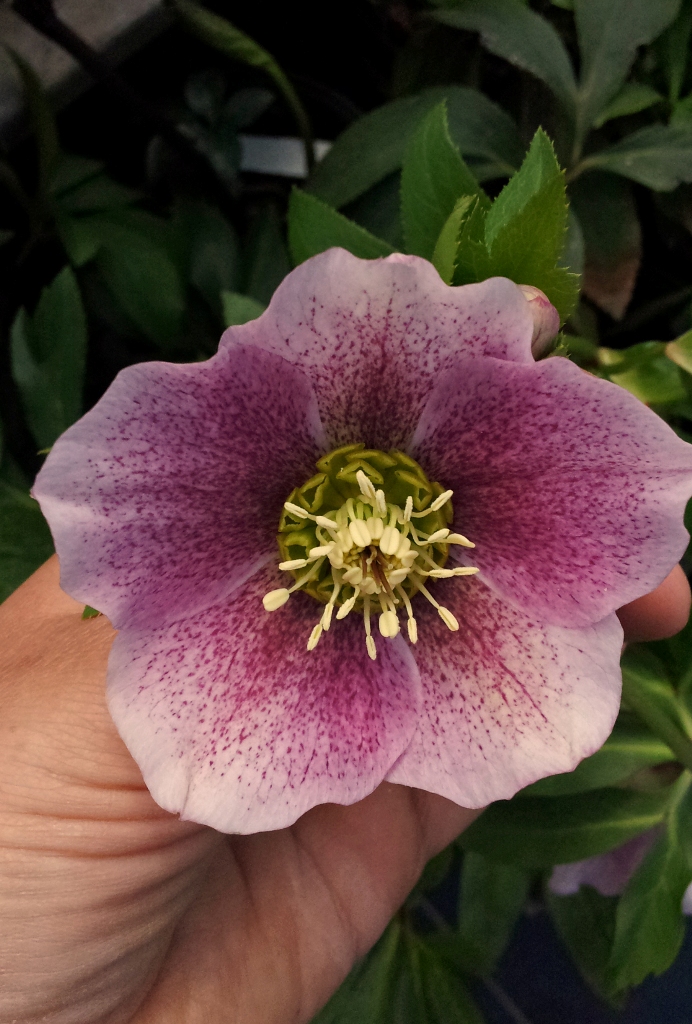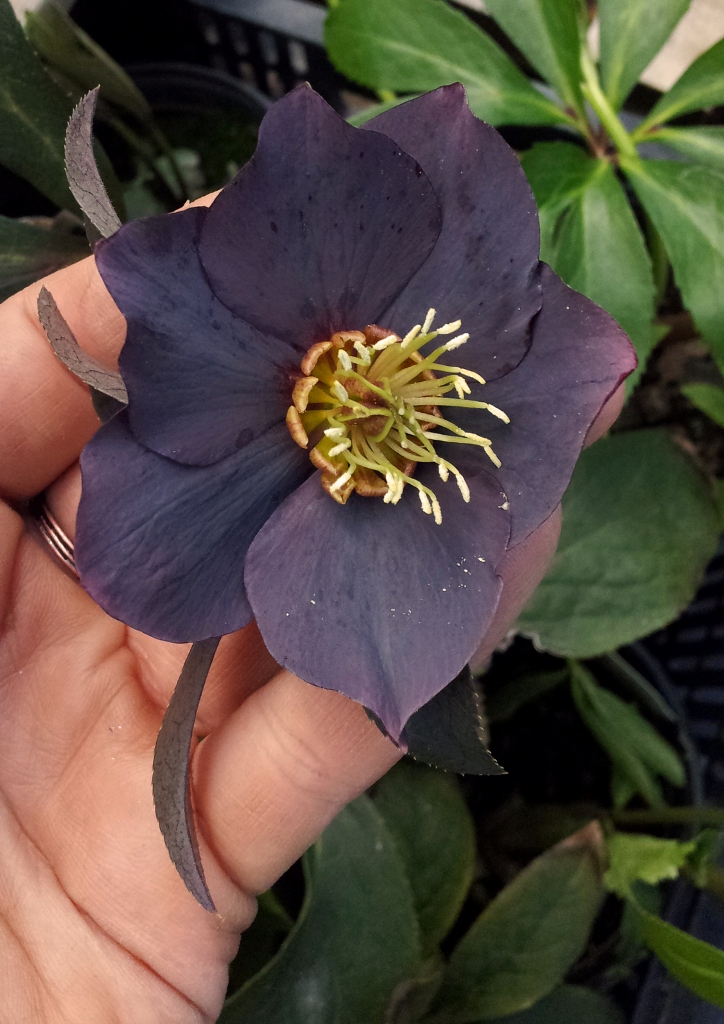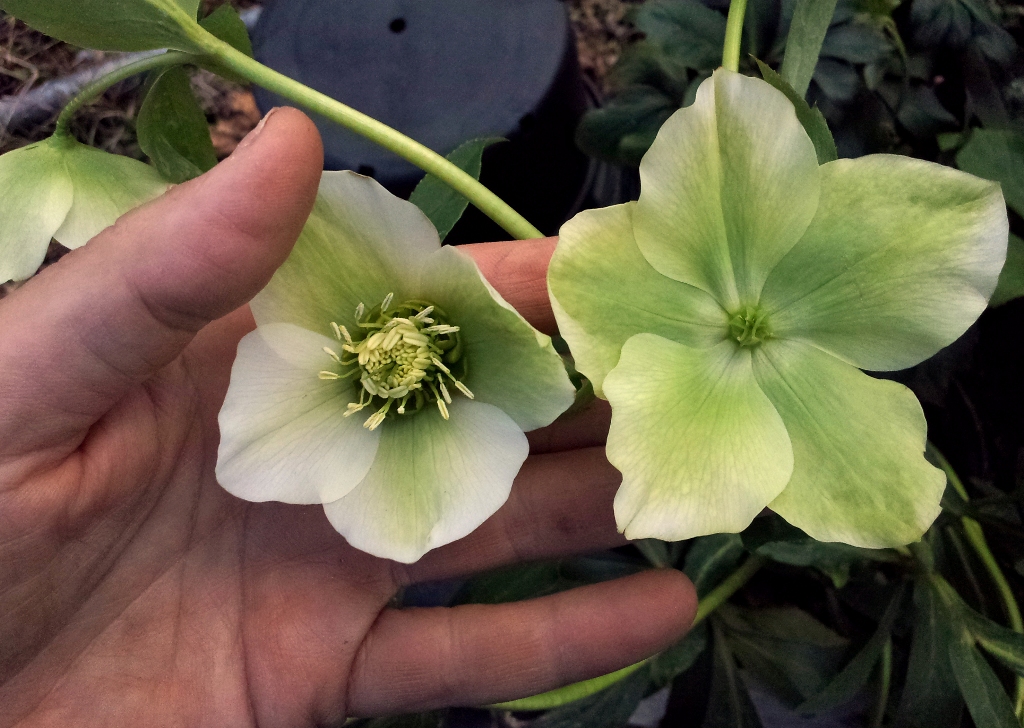
Has it really been six years since I wrote my original blog post on how to harvest hellebores?? Time flies! Since the season to harvest hellebores is about to be upon us again here in the Northeast, it seems a good time to dust off this old tutorial and make sure you all are getting the most out of your precious hellebores! They really are such a treat to have in spring bouquets!
How to Harvest Hellebores
Hellebores became all the rage right in floral design sometime around 2012 and they’ve remained a favorite ever since, especially among farmer florists who are anxious for a sturdy bloom in early spring design work. Since hellebores are one of the first flowers to bloom each spring, often even before the snow is melted, we’re all still pretty desperate for some color in our lives. Their nodding heads are charming; their colors and patterns delicious! Oh so tempting to cut and put into a vase!! But it pays to be patient and not cut these garden beauties too soon!

I first fell in love with hellebores as an ornamental plant for my tiny shade garden at my first house in Philly, way back in 2004. But I soon found myself cutting them to take inside to enjoy. After all, who wants to stand outside and adore them in the freezing cold?! Fast forward to 2019 and my hellebore collections has well over 200 plants (and counting!) and probably nearly as many varieties!
Before you ask me exactly what varieties are best for cutting, I’ll let you in on a little secret: buy your hellebore plants in the spring while they are actually blooming in their pots at the nursery so you can see how tall the flower stems are and if their heads face down or up. Hellebore genetics are notorious for crossbreeding and so even a named cultivar may have different traits from plant to plant. So I find it better to see what you’re buying before investing in these pricey pretties. If forced to recommend one variety, I can say I do have quite a good many plants from the Brandywine series.
Now, as a flower farmer, I get asked frequently about how to make hellebores “last” in the vase. So many designers try to use them, only to have them wilt quickly. There are some tricks out there for “post-harvest” treatments that may help with wilting. Some people push a pin up the stem, some people dip them in boiling water, and some people use a chemical quick hydrating solution. And some people use all three. In my experience, there’s only one sure-fire way to get long-lasting hellebores. . .
Harvest hellebores when they are mature.
That’s it. It’s that simple. Harvest hellebores when they are mature, and they’ll not wilt.

The showy petals of a hellebore “bloom” are actually not petals at all, but rather something called sepals. They serve as protection for the flower part which are actually at the center of the showy sepals, consisting of a cluster of finely textured stamens and rather small and insignificant petals (in the photo above, the ruffled green at the center are the petals). Once the flower is fertilized, the stamens and petals are shed, and a seed pod starts to form at the center of the sepals.
The best bet to get hellebores to last in floral arrangements is to use ones that have their seed pods formed. The more developed the seed pod, the sturdier the hellebore will be. This is because the sepals become stiff and waxy as the seed pod develops, which helps them resist wilting. A really mature hellebore can actually hold up beautifully out of water for a day or more. They’re great for boutonnieres and hair flowers!
Can you spot the hellebores that are almost ready to harvest and the ones that aren’t?
Another trick that I’ve learned over the years is to harvest my hellebore stems with a sharp knife rather than scissors/snips. The knife makes a clean cut that does not crush the cells in the tender stem of the hellebore the way snips would. If a stem is particularly thick at the bottom, I’ll make an inch slit up the middle with the knife as well to help open up more water-absorbing tissue. This step is not necessary if the seed pods are well-developed, but sometimes when I’m in a hurry to harvest some blooms that are a little on the young side for a particular wedding or event, I’ll take the extra measure, just to be safe.
Now that I’ve got you all excited about growing hellebores for cutting, go order some from North Creek Nurseries, my favorite supplier.






Thanks so much Jennie. I feel enlightened.
Thanks for this !! Lenten roses are our favorite too. I did go onto the North Creek Nursery website however it states it is for the wholesale trade only…
Is there another url for those of us who are not wholesalers?
Thanks.
Thanks for the comment, Roe. For buying for your home garden, you’re best bet is to check out a local, independent garden center. This is the time of year to shop for them so you can see what the flowers look like on the plants you’re buying. 🙂
I found mine at a Trader Joe’s in Sarasota, Florida. They sell them around February and the plants were $10 each!
Thanks so much for the detailed information. Appreciate you sharing your experience and expertise.
Thank you for teaching me about this beautiful gem of a flower.
I have had Helebores growing in my garden for about ten years, they have become quite prolific and I have never before thought to use them as cut flowers! Now that I know, I’ll be using them for my Easter centerpiece. Thank you for this revelation!
Fantastic, Pam! So happy to help!
Hi I sure enjoy reading your blog. Thanks for sharing about Lenten roses. They certainly are tough and resilient plants in my experience. I have transplanted mine a few times (house to house) cannot leave beloved plant behind.
Thank you for sharing this article, it was great reading and a new addition to my knowledge of flowers
So they are prettier when the seed pod is not mature?!?! What to do, oh my…….
Thank you so much for this article! I’ve read that helebores are poisonous to the touch. Are they not poisonous if harvested before the seed pod develops? I’d like to put some in a low frog vase and want to be careful if necessary.
I have never heard that they are poisonous to the touch. I’ve harvested thousands of stems with my bare hands over many years and have never had any sort of reaction.
I had a garden with thousands of Hellebores for about 30 years. Only today did I find out why they wilted when I brought a bunch indoors, amazing! Now I have a few in my tiny garden and picked a bunch which I know won’t wilt. Thanks.
Can you give any suggestions for whee to plant these for cut flower production if no mature trees are available to shade them? Any other ideas for giving them what they need? Thank you!!
You can build a shaded tunnel or arbor to go over them. For example, you could grow a climbing rose up and over a large trellis and then plant the hellebores under the trellis in the shade from the rose.
I plant mine on the north side of my house and in my garden behind on in the shade of shrubs.
Thanks for the information! I have fresh cuttings and am also wondering if I am able to harvest the seeds from these pods? Is the process any different than for when they are still on the ground?